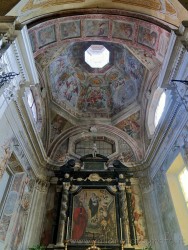|
Andorno Micca (Biella)- Church of San Lorenzo
|
|
|
Show to visit in the Biella area: |
 The church of San Lorenzo in Andorno is a very special church. It has in fact two facades. Or rather it has what was once the original façade and which now forms the back of the church, and then it has the current facade, on the side opposite to the first one. The church of San Lorenzo in Andorno is a very special church. It has in fact two facades. Or rather it has what was once the original façade and which now forms the back of the church, and then it has the current facade, on the side opposite to the first one.
The building, in its original form, was built, as is evident from a date discovered on one of the oldest parts of the church walls, in the fifteenth century (moreover in place of an even older church). The Church of San Lorenzo in Andorno turns therefore out to be one of the oldest churches of the Biella area.
The present church has a basilica shape, with a rectangular plan consisting of three naves divided into five spans, with the lateral naves more narrow and lower.
The exterior of the church reflects well the complexity of its history. The original facade of the late fifteenth century, now back wall of the church, still has the typical division into three vertical parts separated by pilasters and corresponding to the internal division into naves, as well as the decoration with hanging arches under the roof. Also the two windows in Gothic style and the central oculus survived, all three surrounded by glazed terracotta decorations representing faces of cherubs interspersed with vegetal elements. The entrance door, instead, which was still present a few decades ago, is now walled.
The present facade, of the eighteenth century, is a typical baroque facade. It is flat in the upper half, while the lower part has a concave curvature that gives rise to a small atrium, in which there are three doors of which only the central one introduces in the church, of the other two one leads to the Baptistery, the other to the choir.
Both sides of the church are far from being plan and smooth and clearly show that parts have been gradually added at different times, even one above the other. There are still some side windows of the original gothic church visible (the one corresponding to the old facade).
The sparkling gray bell tower all in syenite has a square shape and smooth surfaces; lacking the cusp it appears a bit squat. The tradition says that this is due to a fatal accident occurred during the works of adaptation and raising of the old tower. A worker (or perhaps the construction manager) fell from the very high wall smashing on the ground and so the ambitious inhabitants of Andorno abandoned the project. Nevertheless the bell tower is the highest in the Biella area, with a height of mt. 60.
The interior is decorated in typical Baroque style, with almost all surfaces covered with frescoes. Inside the church there are the remains of the painter and set designer Bernardino Galliari. Among the paintings present noteworth in particular a painting of the Martyrdom of St. Lawrence (above the main altar), by the same Bernardino Galliari. Of note are also the pulpit carved during the second half of the seventeenth century, the organ on the counter facade and the chapel of San Giulio (large photo), built around 1680 on the occasion of the donation of the body of the saint and containing, among others, frescoes by Pietro Lace of Andorno, the same who painted the frescoes on the vaults of the Church of San Giovanni in Veglio and the large church of the Sanctuary of the Moorland. The frescoes on the ceiling of the main nave and on the interior of the dome of the presbitery appear instead to be painted in the nineteenth century.
Categories: Places of historical value of artistic value
45.61216, 8.05339 |
Church of San Lorenzo: Further pictures in the section Photography |